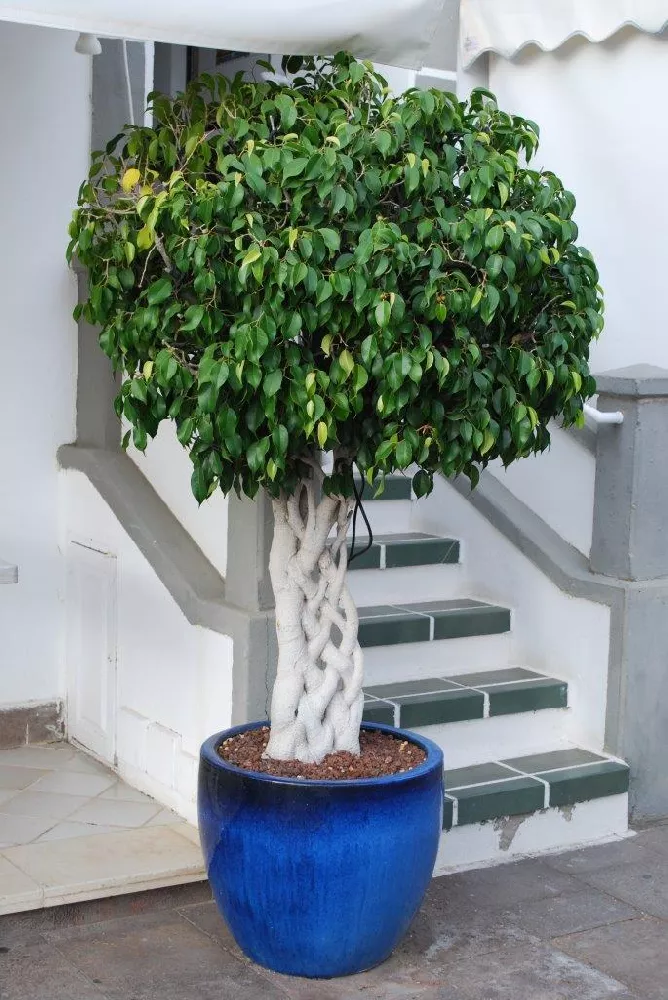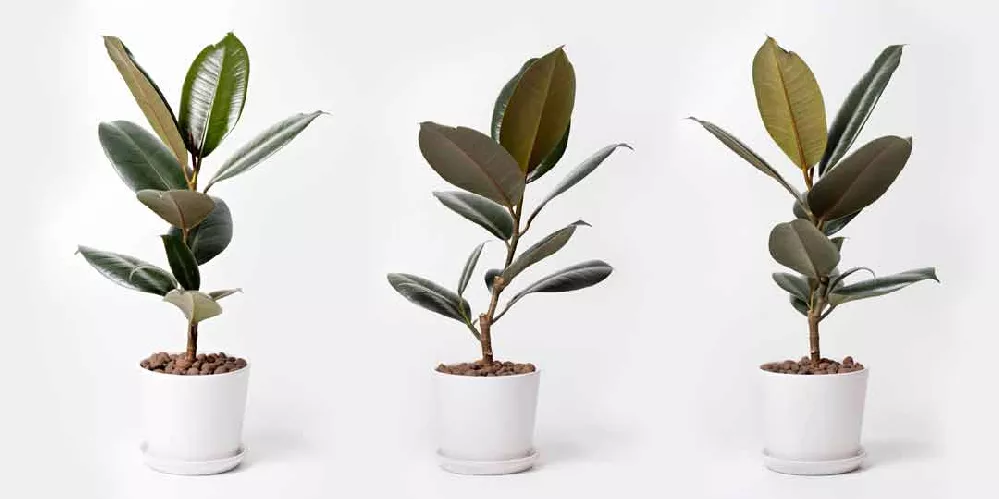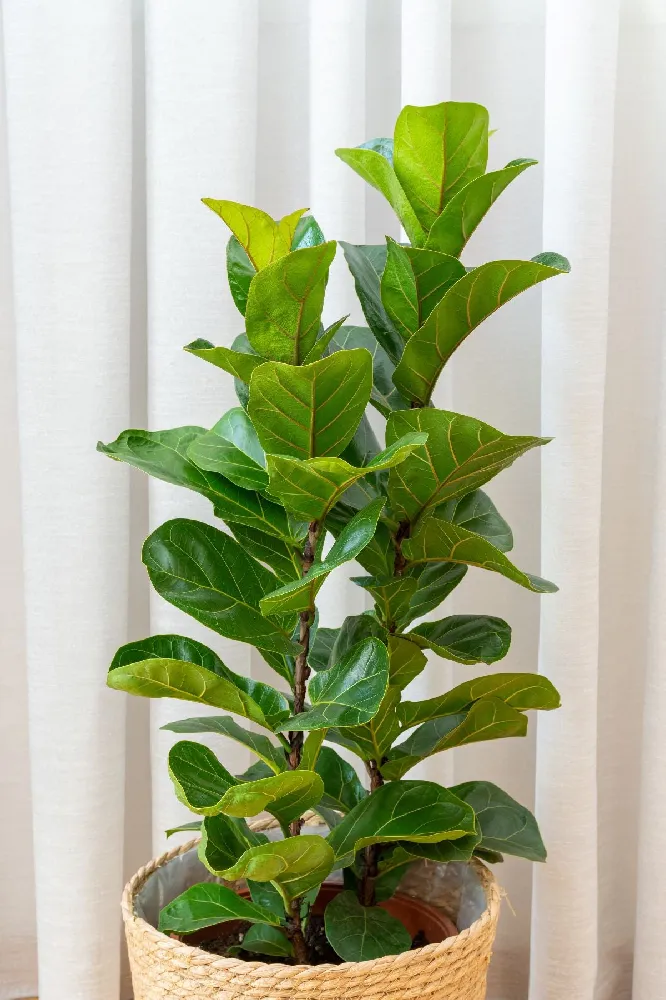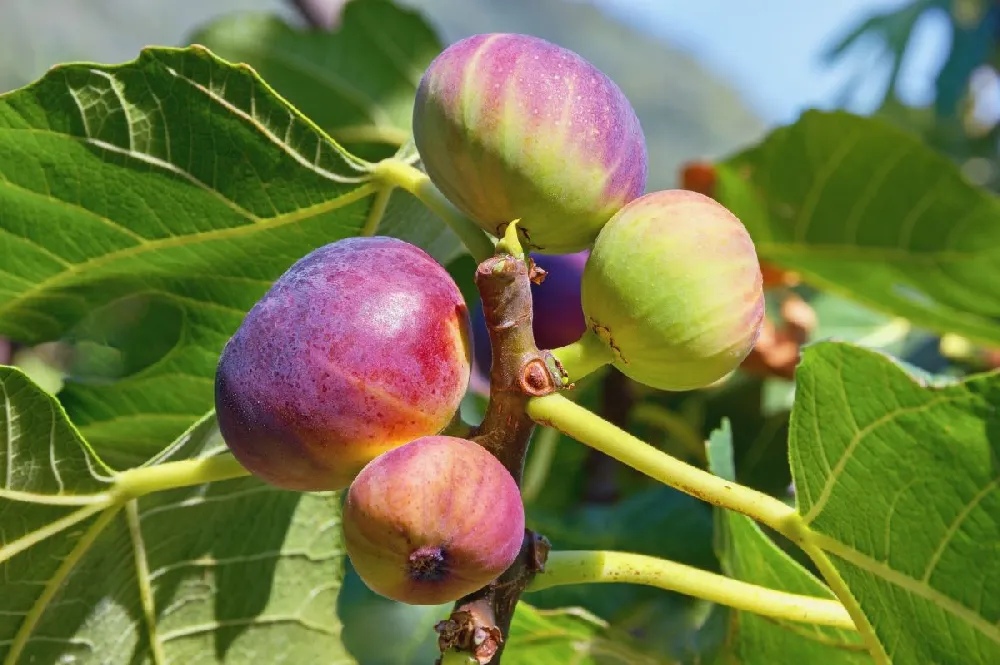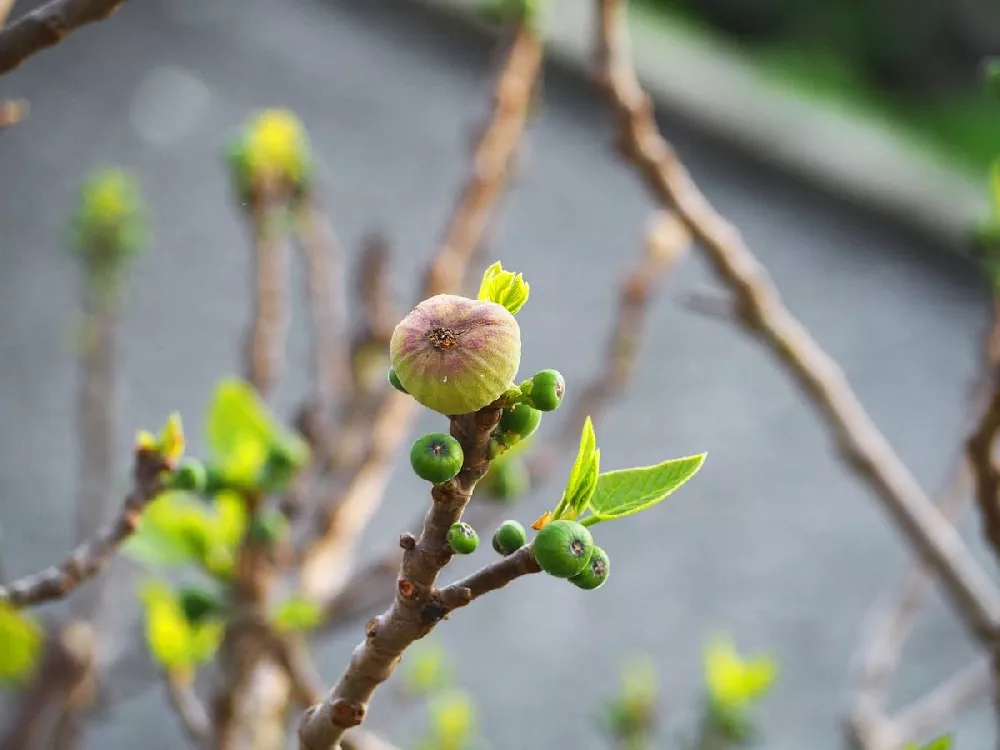- Home >
- Houseplants >
- Braided Benjamina Ficus Trees
Braided Benjamina Ficus Trees for Sale - Buying & Growing Guide
- Ships in 1-2 days
- 1-Year Warranty Eligible
- Pots or accessories are not included unless specified in the product options.
Shipping Details:
Once your order is shipped, you’ll receive an email with a tracking number and estimated delivery date. Most orders ship immediately, but some items are seasonal and may only ship in spring or fall. These products are noted on the website.
Plant Species
There are many different varieties of the Ficus benjamina plant, many of them commonly found in the wild. Here are the four most common species.
Midnight Beauty
The midnight beauty is always linked to the Ficus indigo. It has very dark and bluish (almost black) leaves that have a bright glossy look. The leaves sit on the stem in close internodes. The growth pattern of the Midnight Beauty is upright, and it has a strong apex dominance.
Over the years, the plant has become a favorite among gardeners who prefer having their Weeping Fig plant indoors.
Starlight
This is a rather low-maintenance species of the Ficus benjamina. It is a shrub that is large and evergreen. The best way to identify it is by the leaves, which are very slender and have a creamy white/yellow margin. It is one of the most attractive varieties when kept indoors
Monique
Ficus Monique is a rather upright species of the Weeping Fig with a bushy kind of growth pattern. Its glossy leaves have ruffled edges that are bright green.
When exposed to lower light intensity, its ruffled leaves become accentuated and when mature, the leaves on Ficus Monique become hard and crispy.
Many people like it because of how resistant it is to shedding its leaves, a feature that greatly sets it apart from the rest of the Ficus Benjamina species.
Planting the Weeping Fig
When planting the Weeping Fig, you have to ensure that you have a loosely mixed soil that drains well.
The plant does very well when exposed to bright light, but it can also do considerably well in partial shade.
When grown indoors, you should select a convenient spot where you won’t need to move it very often. It doesn’t like being moved from one place to another. When moved, it reacts by shedding of all its leaves and replaces it with new ones. It immediately adapts to the light intensity of the new location.
Plant Care Instructions
You might be very discouraged when trying to grow the Weeping Fig indoors because of the level of care it needs. The fact that it responds to every problem with shedding off its leaves does not make the situation any better either.
However, with just these simple steps, it is one of the best plants you can keep indoors. It is also important to note that the plant highly tolerates growth in poor conditions.
Light
Light plays a big part in the life of a Weeping Fig. When you look at its origin, you’ll realize it came from the tropics where there is abundant sunshine. Though it has greatly evolved, light is still a major part of what makes it grow well.
Water
Keep it moderately watered at all times. The soil need not be soggy, but it is imperative that it is not too dry either. Too much water in the plant causes it to shed all the leaves, and it might cause root rot in extreme cases.
Another very important thing to note is that the Weeping Fig is very sensitive to most of the chemicals found in city tap water, such as chlorine and fluoride. Therefore, when watering, use only distilled water, or you can let the chemicals in the tap water dissipate by letting it sit overnight.
Soil
The Weeping Fig grows well in well-draining soils. Soils that retain a lot of water can cause the roots to rot.
Fertilizer
While the Weeping Fig is very wild when grown outside and also grows very fast, when grown indoors, it is the opposite situation whereby you will have to add fertilizer to it at least once a month between the months of April and September to enhance its growth.
Re-Potting
The growth levels of the F. benjamina are relatively low, so you might not have any need for re-potting for the first 4-5 years.
It is better to avoid moving the plant unnecessarily because as we have seen, moving the plant causes it to shed all its leaves.
Pruning
When you see that your Wedding Fig plant has overgrown than you want, or there are broken and dead growth of your plants, it’s time to do a renewal pruning.
It’s advised that your plant should be pruned after its active growth period. And always remove no more than a third of the branches. Make the cut near the trunk, the growth node, where the new growth will sprout.
Propagation
The Weeping Fig can be easily rooted just from the cuttings without using a rooting hormone.
We recommend taking the cuttings during the warmer seasons for them to have enough supply of moisture and warmth.
It is very hard for any a Ficus tree to grow from a seed. Also, it is not common to see plants grown indoors yield any fruit or seed.
Common Problems, Pests, and Diseases
Insects and Pests
The most common insects found on the Weeping Fig are thrips. Others include aphids, mealybugs, and whitefly.
There are various diseases that might attack your plant whether it is planted indoors or outdoors. This is irrespective of how good you are at gardening. Some diseases find their way to the plant no matter what you do.
Signs of Pests or Diseases
Brown or yellowish spots on the leaves or even dropping leaves are a typical sign of fungus.
Leaves getting stuck together or sticky liquid dropping off the leaves show an invasion of either scales or spider mites.
Pests can also cause the plant to have dry leaves that continuously fall off the plant.
How to Remove the Fungus
Using a cotton stick, rinse out the area that is contaminated with a fungicide. Neem oil is a favorite among many people because it is locally available, very effective, and also safe to use in the house.
When you realize one of your plants has an infection or that it has been infested by pests, immediately separate it from the rest. This will greatly reduce the chance of the infection or the pests spreading to the other plants.
Keeping the leaves dry and not overwatering also greatly reduces the risk of infections on a Weeping Fig.
Pruning the plant regularly, including taking away dead branches and picking up dead leaves, is very vital in ensuring that pests and even diseases are controlled.
Drought
Once it is established, the F. benjamina is highly drought and heat-resistant. It rarely dries up even during the summer unless there is a severe drought.
Hard Frost
Hard frost can damage Weeping Fig badly. It is, therefore, very important that the roots are protected during the winter because this is the only way for it to rebound once the cold season is over.
Strong Winds
Due to their arched branches, Weeping Figs are prone to breakage in the case of strong winds. The best way to counter this is by planting it where it is protected from the wind.
The best way to take care of a Weeping Fig planted outdoors is to keep the soil moist but not wet. During the winter, try to protect its roots from the harsh winter weather.
Conclusion
The Weeping Fig is a very interesting plant to have around. It can live for a long time, and with the proper care, you will have it as a companion for very many years.
FAQs
My Weeping Fig has been shedding its leaves from the beginning of fall. What should I do?
Weeping figs tend to shed some of its leaves in the beginning of fall. This can be explained by its origin where they have to shed most of their leaves at the beginning of every dry season. If you notice this, lightly mist it to increase the humidity, but don’t be tempted to overwater it as this might cause other problems.
My plant has very few pale and springy leaves. What could be the problem?
This shows a lack of enough light. Try changing its position to a place with more ample sunlight.
The leaves on my Weeping Fig are dry and are falling off. What should I do?
These kinds of leaves could mean that your plant is underwatered. Check the soil that it is planted in and if you find that it is very dry, try soaking the whole pot in lukewarm water for a few minutes. Then continue with an adjusted watering schedule.
How often should I prune my Weeping Fig?
If planted outdoors, it is important that you prune it regularly. When planted indoors, however, you only need to prune it when you see dead leaves or branches.
There are yellowish spots on my Weeping Fig. What could it be?
Yellow or brownish spots on a Weeping Fig shows that it has fungus. Rinse it with Neem oil and make sure you separate it from your other plants to avoid spreading the infection.
Compare Similar Products
Customer Reviews
 A bit small
A bit smallThe quality is good but the overall size is pretty small.
 Braided Benjamina Ficus Tree
Braided Benjamina Ficus TreeThe ordering and shipping process was wonderful. When the tree arrived it dropped a ton of leaves for several weeks straight, and I started to worry it wouldn't recover. I finally see some new growth and new leaves opening, though! Hopeful it will adjust to its new home!
 Ficus tree
Ficus treeLooked amazing when it arrived. We let it settle in its spot for a few weeks then I placed in a new pot. Still looks great.
 Great price and size + convenience
Great price and size + convenienceIt was great! We've been looking for a indoor plant / tree that was large for awhile now. Most nurseries and stores all carried the same local stuff. No many options. It was a great change to see we could order online a big plant / tree that would be delivered to our home. We will be back!
